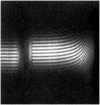Extended Fujita approach to the molecular weight distribution of polysaccharides and other polymeric systems
- PMID: 21276851
- PMCID: PMC3480191
- DOI: 10.1016/j.ymeth.2011.01.009
Extended Fujita approach to the molecular weight distribution of polysaccharides and other polymeric systems
Abstract
In 1962 H. Fujita (H. Fujita, Mathematical Theory of Sedimentation Analysis, Academic Press, New York, 1962) examined the possibility of transforming a quasi-continuous distribution g(s) of sedimentation coefficient s into a distribution f(M) of molecular weight M for linear polymers using the relation f(M)=g(s)·(ds/dM) and showed that this could be done if information about the relation between s and M is available from other sources. Fujita provided the transformation based on the scaling relation s=κ(s)M(0.5), where κ(s) is taken as a constant for that particular polymer and the exponent 0.5 essentially corresponds to a randomly coiled polymer under ideal conditions. This method has been successfully applied to mucus glycoproteins (S.E. Harding, Adv. Carbohyd. Chem. Biochem. 47 (1989) 345-381). We now describe an extension of the method to general conformation types via the scaling relation s=κM(b), where b=0.4-0.5 for a coil, ∼0.15-0.2 for a rod and ∼0.67 for a sphere. We give examples of distributions f(M) versus M obtained for polysaccharides from SEDFIT derived least squares g(s) versus s profiles (P. Schuck, Biophys. J. 78 (2000) 1606-1619) and the analytical derivative for ds/dM performed with Microcal ORIGIN. We also describe a more direct route from a direct numerical solution of the integral equation describing the molecular weight distribution problem. Both routes give identical distributions although the latter offers the advantage of being incorporated completely within SEDFIT. The method currently assumes that solutions behave ideally: sedimentation velocity has the major advantage over sedimentation equilibrium in that concentrations less than 0.2mg/ml can be employed, and for many systems non-ideality effects can be reasonably ignored. For large, non-globular polymer systems, diffusive contributions are also likely to be small.
Copyright © 2011 Elsevier Inc. All rights reserved.
Figures












Similar articles
-
Molecular weight distribution evaluation of polysaccharides and glycoconjugates using analytical ultracentrifugation.Macromol Biosci. 2010 Jul 7;10(7):714-20. doi: 10.1002/mabi.201000072. Macromol Biosci. 2010. PMID: 20632365 Review.
-
Application of novel analytical ultracentrifuge analysis to solutions of fungal mannans.Eur Biophys J. 2017 Apr;46(3):235-245. doi: 10.1007/s00249-016-1159-5. Epub 2016 Jul 21. Eur Biophys J. 2017. PMID: 27444285 Free PMC article.
-
Ultracentrifuge Methods for the Analysis of Polysaccharides, Glycoconjugates, and Lignins.Methods Enzymol. 2015;562:391-439. doi: 10.1016/bs.mie.2015.06.043. Epub 2015 Aug 21. Methods Enzymol. 2015. PMID: 26412662 Review.
-
Assessing sedimentation equilibrium profiles in analytical ultracentrifugation experiments on macromolecules: from simple average molecular weight analysis to molecular weight distribution and interaction analysis.Biophys Rev. 2016;8(4):299-308. doi: 10.1007/s12551-016-0232-8. Epub 2016 Nov 22. Biophys Rev. 2016. PMID: 28003857 Free PMC article. Review.
-
Recent development of chitosan-based polyelectrolyte complexes with natural polysaccharides for drug delivery.Int J Biol Macromol. 2014 Mar;64:353-67. doi: 10.1016/j.ijbiomac.2013.12.017. Epub 2013 Dec 17. Int J Biol Macromol. 2014. PMID: 24360899 Review.
Cited by
-
Analytical Ultracentrifugation as a Matrix-Free Probe for the Study of Kinase Related Cellular and Bacterial Membrane Proteins and Glycans.Molecules. 2021 Oct 8;26(19):6080. doi: 10.3390/molecules26196080. Molecules. 2021. PMID: 34641622 Free PMC article. Review.
-
A glycoconjugate of Haemophilus influenzae Type b capsular polysaccharide with tetanus toxoid protein: hydrodynamic properties mainly influenced by the carbohydrate.Sci Rep. 2016 Feb 26;6:22208. doi: 10.1038/srep22208. Sci Rep. 2016. PMID: 26915577 Free PMC article.
-
Variable Field Analytical Ultracentrifugation: II. Gravitational Sweep Sedimentation Velocity.Biophys J. 2016 Jan 5;110(1):103-12. doi: 10.1016/j.bpj.2015.11.027. Biophys J. 2016. PMID: 26745414 Free PMC article.
-
Overview of current methods in sedimentation velocity and sedimentation equilibrium analytical ultracentrifugation.Curr Protoc Protein Sci. 2013 Feb;Chapter 20:Unit20.12. doi: 10.1002/0471140864.ps2012s71. Curr Protoc Protein Sci. 2013. PMID: 23377850 Free PMC article.
-
The Svedberg Lecture 2017. From nano to micro: the huge dynamic range of the analytical ultracentrifuge for characterising the sizes, shapes and interactions of molecules and assemblies in Biochemistry and Polymer Science.Eur Biophys J. 2018 Oct;47(7):697-707. doi: 10.1007/s00249-018-1321-3. Epub 2018 Jul 28. Eur Biophys J. 2018. PMID: 30056489 Free PMC article.
References
-
- Fujita H. Mathematical Theory of Sedimentation Analysis. Academic Press; New York: 1962.
-
- Wyatt PJ. Combined differential light scattering with various liquid chromatography separation techniques. In: Harding SE, Sattelle DB, Bloomfield VA, editors. Laser Light Scattering in Biochemistry. Royal Society of Chemistry; Cambridge: 1992. pp. 35–58.
-
- Horton JC, Harding SE, Mitchell JR. Gel permeation chromotography - multi angle laser light scattering characterization of the molecular mass distribution of “Pronova” sodium alginate. Biochem Soc Trans. 1991;19:510–511. - PubMed
-
- Harding SE, Vårum KM, Stokke BT, Smidsrød O. Molecular weight determination of polysaccharides. In: White CA, editor. Advances in Carbohydrate Analysis. JAI Press; Birmingham, UK: 1991. pp. 63–144.
-
- Jumel K, Fiebrig II, Harding SE. Rapid size distribution and purity analysis of gastric mucus glycoproteins by size exclusion chromotography/multi angle laser light scattering. Int J Biol Macromol. 1996;18:133–139. - PubMed
Publication types
MeSH terms
Substances
Grants and funding
LinkOut - more resources
Full Text Sources
Other Literature Sources

